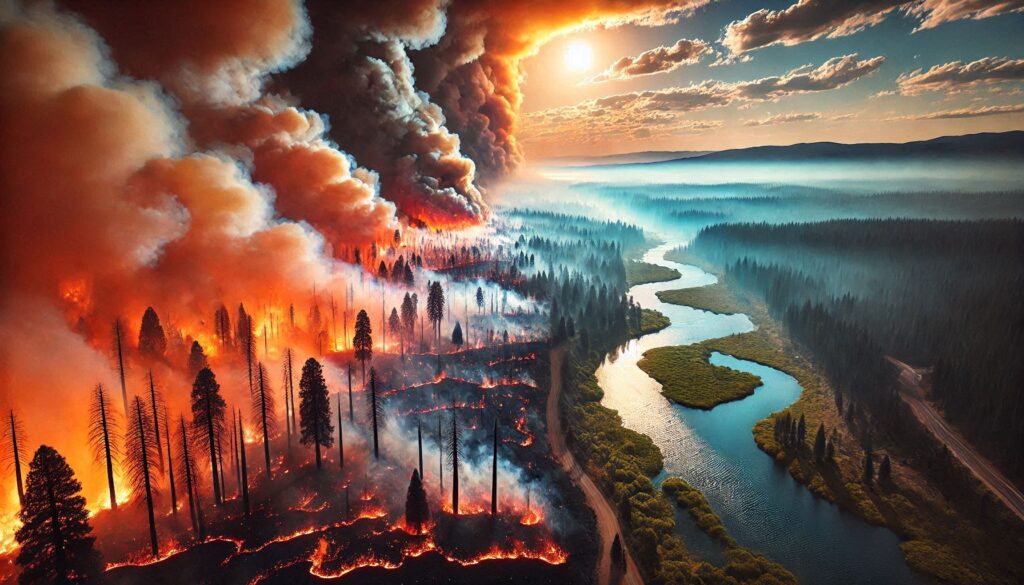Wildfires have long been a natural part of ecosystems, but the scale and intensity of recent wildfires, such as those currently raging across Los Angeles, underscore a growing crisis. The Palisades Fire and Eaton Fire are devastating thousands of acres, displacing residents, and putting immense pressure on emergency resources. These catastrophic events highlight the interconnected nature of climate change, resource management, and community preparedness.
In this blog, we’ll delve into how wildfires are linked to climate change, the significant role of water management in both prevention and recovery, and how innovative approaches can help build resilience against future disasters.
Climate Change and the Rising Wildfire Threat
Climate change is no longer a distant threat—it is here, reshaping our environment in tangible ways. Rising global temperatures, prolonged droughts, and erratic weather patterns are creating the perfect storm for wildfires to thrive. According to NASA, the past decade has seen the hottest years on record, with 2023 marking another record-breaking summer.
How Climate Change Fuels Wildfires
- Extended Dry Seasons: Warmer temperatures lead to longer periods of dry weather, reducing soil moisture and increasing the flammability of vegetation.
- Stronger Winds: Climate change affects wind patterns, making it easier for fires to spread rapidly.
- Increased Lightning Strikes: Rising temperatures lead to more thunderstorms, which ignite fires in already dry regions.
The ongoing Los Angeles wildfires, including the Palisades Fire, are prime examples of these factors in action. With over 5,000 acres already scorched, the region is grappling with one of the most destructive fire seasons in recent history.
For further reading on the impact of fires and their effects on communities, check out this detailed article from NASA: Fires Tear Through Los Angeles.
The Role of Water in Wildfire Dynamics
Water is both a victim and a critical tool in wildfire situations. On one hand, wildfires deplete water resources, disrupt supply chains, and contaminate water quality. On the other hand, efficient water management is crucial for firefighting efforts and post-disaster recovery.
Wildfires and Water Quality
When vegetation burns, it releases ash, debris, and chemicals into nearby water sources. This can lead to contamination of reservoirs and rivers, as seen in the aftermath of California’s 2018 Camp Fire. Contaminants such as benzene and heavy metals were detected in the water supply, making it unsafe for consumption.
Additionally, erosion caused by the loss of vegetation can lead to sediment build-up in water bodies, further complicating water treatment efforts.
Firefighting’s Impact on Water Supply
Fighting wildfires requires vast quantities of water. In regions already facing drought conditions, this puts a strain on available resources. For instance, during the 2020 Creek Fire, California’s firefighting teams used over 10 million gallons of water in a single week. Such high demand exacerbates existing water shortages, leaving communities vulnerable.
Innovative Water Management: The Path Forward
The current crisis in Los Angeles serves as a wake-up call for improving water management and building resilience against climate-induced disasters. Companies like Genviss are pioneering new approaches to ensure sustainable and effective water treatment solutions.
Real-Time Water Quality Monitoring
Advanced sensor technologies allow for continuous monitoring of water quality, ensuring that contaminants are detected and treated promptly. Such systems are particularly crucial in wildfire-prone areas, where water supplies can be compromised overnight.
Resilient Infrastructure
Investing in fire-resistant water infrastructure can minimize the damage caused by wildfires. For example, underground water pipelines and insulated reservoirs are less likely to be affected by extreme heat.
Decentralized Water Treatment Systems
Portable water treatment units can be deployed in disaster zones to provide immediate access to clean water. These systems are vital for ensuring that displaced communities have access to safe drinking water.
Sustainable Water Practices
Simple but effective practices, such as rainwater harvesting and greywater recycling, can help mitigate the impact of droughts and ensure a steady water supply during emergencies.
Community Preparedness: A Key to Resilience
While governments and organizations play a significant role in disaster management, community involvement is equally important. Educating residents about sustainable practices, evacuation plans, and resource conservation can make a significant difference during emergencies.
Steps Communities Can Take
- Adopt Fire-Resistant Landscaping: Planting fire-resistant vegetation and maintaining defensible spaces around homes can reduce the risk of property damage.
- Conserve Water: Simple actions like fixing leaks, using water-efficient appliances, and reducing outdoor water use can help preserve water supplies.
- Stay Informed: Relying on credible sources such as Ready.gov for updates ensures timely and accurate information during emergencies.
The Role of Genviss in Climate Resilience
At Genviss, we understand that water management is at the heart of climate resilience. Our advanced water treatment technologies and sustainable solutions are designed to tackle challenges like those posed by the Los Angeles wildfires. By focusing on innovation and community engagement, we aim to create a future where clean water is accessible to all, even in the face of climate change.
Our Commitment
- Innovative Solutions: From real-time monitoring to portable treatment systems, we provide cutting-edge technologies for water management.
- Sustainability: Our practices are aligned with global sustainability goals, ensuring minimal environmental impact.
- Community-Centric Approach: We collaborate with local communities to implement customized water solutions that address specific needs.
Conclusion: Turning Crisis Into Opportunity
The Los Angeles wildfires are a stark reminder of the challenges posed by climate change. However, they also offer an opportunity to rethink and innovate our approach to water management and disaster preparedness. By investing in resilient infrastructure, adopting sustainable practices, and leveraging advanced technologies, we can build a future that is not only more secure but also more sustainable.
As we navigate these challenges, it is crucial to stay informed, take proactive measures, and support organizations like Genviss that are working to make a difference. Together, we can turn the tide against climate change and ensure a safer, more resilient world for generations to come.

